The city of Leiden has announced plans to develop the 6 km long fortification walls (Singel) encircling the historic city centre into the “longest, most beautiful and exciting city park in the Netherlands.” A few weeks ago I gave a lecture on linear parks to a public meeting about the new park, as part of the preparations for the drawing up of a competition brief for the project. I expected a modest turn-up, but the venue was packed with over a hundred politicians, administrators, designers and residents. There was a buzz of camaraderie and collective energy in the meeting, such a contrast to the distrust and reservation that mostly accompanies public meetings about urban developments. That may be because parks are relatively harmless affairs but it may also have to do with the fact that the term park has become so ubiquitous that concept is open to any and all interpretations. Parks can be anything and everything, so how could you be against them?

The inclusiveness the term park is the result of an historical process; in the course of time the park has substantially developed, transmuted and diversified. Today, the term has a broad range of interpretations within differing contexts. ‘Park’ is used in reference to public open space facilities such as recreation areas, playgrounds, sports fields and manifestation areas, but also denotes green space typologies ranging from remnant landscapes to buffer zones and even ecological corridors. Heritage landscapes within urban areas are also regularly referred to as parks – as are theme parks, vacation parks and zoological gardens. The term also appears in recent formulations such as Regional Park, Landscape Park, Metropolitan Park, Pocket Park and Country Park, and has even found usage in urban developments bearing little relationship to the (historical) park model, such as industrial areas, technology zones and housing estates. These developments reflect a broader dissolution of the park as definition, prompting the question: What is a park and what is not a park?
Despite its ubiquity, there is a relatively limited ‘body of knowledge’ and critical theory on the park – from an historical, cultural, sociological or design perspective – to discuss these elementary kinds of questions. The ‘diaspora’ of the park also presents a challenge to its political, social, cultural, experiential and design traditions, and threatens the distinctive-ness of the urban park as spatial type: its theoretical, methodological and instrumental foundations. While each park is a unique creation arising from the particular morphology of natural, cultural and urban (landscape) conditions, its typological ‘DNA’ remains crucial to spatial design disciplines. The continuing diaspora of the park can be interpreted as an indication of our failure to nurture the park legacy.

To call the Singel in Leiden a park is thus certainly correct within the current broad range of interpretations of the term park – the question is, what else is needed to make it more than a route connecting a series of green spaces – which is something very different than a park. No easy task for a park commissioner or designer, and even less for a sensitive historic site with a linear form. In typo-morphological terms, the Singel park in Leiden is a ‘transformation of infrastructure’ park – in essence the same kind of park as the Promenade Plantée in Paris, or its now internationally famous successor, High Line in New York. Given the crowd at this first public meeting and the commitment of stakeholders, Leiden has the potential to develop a park which can hold its own with Paris and New York. But even if Leiden doesn’t have this level of ambition, the group preparing the competition brief would still do well to study parks like Promenade Plantée and High Line and figure out why these parks can rightly call themselves parks – and why they are so successful.

What is it about the Promenade Plantée and High Line that inspires millions to climb up a long flight of stairs to experience them? What have the designers done to make users equate these projects to other great city parks around the world?
Is it the choreography of views and images along route reminiscent of the dioramas of natural and cultural scenery in the landscape parks of the 19th century? Or is it the clever combination of the diorama with our fetish for jogging circuits and ‘fitness promenading’ – or as Midas Dekkers calls us: the Homo adidas?
Is it the representation of garden, landscape and wilderness through skilful (inverse) compositions and views? Or is it the array of landscape experiences through the inspired use of planting and materials?
Is it the way the projects reconfigure the city as a landscape made up of buildings situated within a larger landscape space, materialized by the linear park? Or is it that they set up a new aesthetic of architecture and nature?
I hope Leiden finds the answers to these questions in the coming weeks and manages to keeps the park type within their sights. Now that they have set the tone so well, anything less than a real park just won’t do, I’m afraid.
References:
Kaashoek, A., Jansen, K., Belt, M., (2011) De Leidse Singels: het langste park van Nederland! Visie Leidse Singels. Leiden
van der Velde, r., de Wit, S., Milanovic, S., (2011) Urban Landscapes Reader, MSc2 Landscape Architecture. Delft.
Dekkers, M. (2006) Lichamelijke oefening. Amsterdam: Uitgeverij Contact




